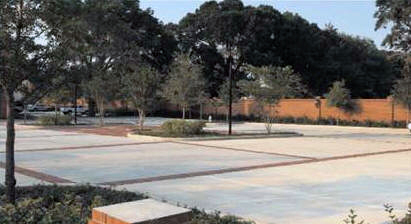Benefits
Environmental Benefits
Benefits | Attractive | Economic | Environmental | Structural | LEED
 Pervious concrete pavement systems provide a valuable stormwater management tool under the requirements of the EPA Storm Water Phase II Final Rule. Phase II regulations provide programs and practices to help control the amount of contaminants in our waterways. Impervious pavements— particularly parking lots—collect oil, anti-freeze, and other automobile fluids that can be washed into streams, lakes, and oceans when it rains.
Pervious concrete pavement systems provide a valuable stormwater management tool under the requirements of the EPA Storm Water Phase II Final Rule. Phase II regulations provide programs and practices to help control the amount of contaminants in our waterways. Impervious pavements— particularly parking lots—collect oil, anti-freeze, and other automobile fluids that can be washed into streams, lakes, and oceans when it rains.
As for oil that drips on and into pervious pavement, several studies have been conducted on the behavior of oil introduced into a pervious pavement system. According to PCA, findings show that the oil is contained within the pervious system as a coating on the large surface area of the void system and at the location of any geotextile fabric separating the pavement from the subbase or subgrade support. Hydrocarbons, such as oils, are a food source for many naturally occurring bacteria and fungi. The microorganisms feed on the oil and biodegrade it into simpler chemical components that are released into the atmosphere. Research has determined that 97.6 to over 99 percent of oils introduced into pervious pavements are trapped and biodegraded.
EPA Storm Water regulations set limits on the levels of pollution in our streams and lakes. To meet these regulations, local officials have considered two basic approaches: 1) reduce the overall runoff from an area, and 2) reduce the level of pollution contained in runoff. Efforts to reduce runoff include zoning ordinances and regulations that reduce the amount of impervious surfaces in new developments (including parking and roof areas), increased green space requirements, and implementation of “stormwater utility districts” that levy an impact fee on a property owner based on the amount of impervious area. Efforts to reduce the level of pollution from stormwater include requirements for developers to provide systems that collect the “first flush” of rainfall, usually about 1 inch (25 mm), and “treat” the pollution prior to release. Pervious concrete pavement reduces or eliminates runoff and permits “treatment” of pollution: two studies conducted on the long-term pollutant removal in porous pavements suggest high pollutant removal rates. The results of the studies are presented in Table 2 below.
|
||||||||||||||||||||||||
*Schueler, 1987, as quoted in EPA, 2004. This data was not collected on pervious concrete systems, but on another porous pavement material.
By capturing the first flush of rainfall and allowing it to percolate into the ground, soil chemistry and biology can then “treat” the polluted water naturally. Thus, stormwater retention areas may be reduced or eliminated, allowing increased land use. Furthermore, by collecting rainfall and allowing it to infiltrate, groundwater and aquifer recharge is increased, peak water flow through drainage channels is reduced, and flooding is minimized. In fact, the EPA named pervious pavements as a BMP for stormwater pollution prevention because they allow fluids to percolate into the soil.
Another important factor leading to renewed interest in pervious concrete is an increasing emphasis on sustainable construction. Because of its benefits in controlling stormwater runoff and pollution prevention, pervious concrete has the potential to help earn a credit point in the U.S. Green Building Council’s Leadership in Energy & Environmental Design (LEED) Green Building Rating System  (Sustainable Sites Credit 6.1), increasing the chance to obtain LEED project certification. This credit is in addition to other LEED credits that may be earned through the use of concrete for its other environmental benefits, such as reducing heat island effects (Sustainable Site Credit 7.1), recycled content (Materials and Resources Credit 4), and regional materials (Materials and Resources Credit 5).
(Sustainable Sites Credit 6.1), increasing the chance to obtain LEED project certification. This credit is in addition to other LEED credits that may be earned through the use of concrete for its other environmental benefits, such as reducing heat island effects (Sustainable Site Credit 7.1), recycled content (Materials and Resources Credit 4), and regional materials (Materials and Resources Credit 5).
The light color of concrete pavements absorbs less heat from solar radiation than darker pavements, and the relatively open pore structure of pervious concrete stores less heat, helping to lower heat island effects in urban areas.
Trees planted in parking lots and city sidewalks offer shade and produce a cooling effect in the area, further reducing heat island effects. Pervious concrete pavement is ideal for protecting trees in a paved environment (many plants have difficulty growing in areas covered by impervious pavements, sidewalks and landscaping, because air and water have difficulty getting to the roots). Pervious concrete pavements or sidewalks allow adjacent trees to receive more air and water and still permit full use of the pavement (see Figure 2b). Pervious concrete provides a solution for landscapers and architects who wish to use greenery in parking lots and paved urban areas.
Although high-traffic pavements are not a typical use for pervious concrete, concrete surfaces can also improve safety during rainstorms by eliminating ponding (and glare at night), spraying, and the risk of hydroplaning.
![]() See Green Building Technology in use at St Anne's Belfield Middle School, VA: Click on "Green Features"
See Green Building Technology in use at St Anne's Belfield Middle School, VA: Click on "Green Features"
A joint project between Allied Concrete and VRMCA.

